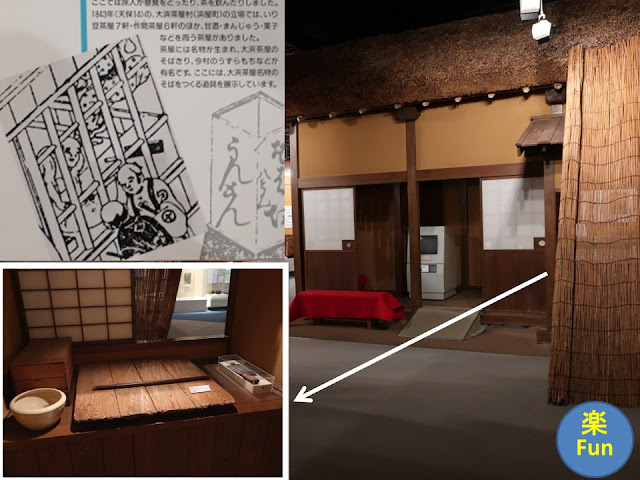Anjo City is around 30km southeast of
Nagoya in central Japan. The museum shows us not only many historical
exhibits but also folklore ones. Happily, I could find many fun things for
people in the old time.
Moreover, there was a special exhibition of a local performance “Mikawa Manzai”. It is introduced in the next post.
愛知県の「安祥文化のさと」の一角にある巨大な博物館です。
古代から現在まで、多くの展示品があり、しかも庶民にも目を向けています。人々の楽しみが沢山見つかりました。しかも、訪問時には三河万歳の企画展が開かれていて、そちらも豊富な展示でした。次の記事で紹介しています。
博物館は、徳川家康の先祖の安成松平氏四代の拠点・安成城の跡にあり、四代の武将キャラが所々に置かれています。流行りの見せ方ですね。上の写真は常設展示室の入り口です。
Primitive age: the source of their livelihood were foods in mountains and seas、安城の原始:山と海の幸に生きる
The lifestyle is explained by artifacts and models. Dogs have always lived with people.
出土品だけでなく、模型でも説明されています。犬はいつも人の暮らしの中にいます。
Ancient time: culture from Kyoto、安城の古代:西からの風
The advanced culture came from western Japan such as Kyoto. Nobles in Kyoto dominated the lands in Anjo. People’s lives in nobles’ private lands are drawn. Unexpectedly, they seem to be happy.
西日本から進んだ文化が入ってきました。荘園は貴族などの私有地ですが、「鎌倉時代以後の絵巻物には、荘園での生活がいきいきと描かれています」と書かれています。意外と楽しそうですね。
“Farmers’ society” in the Edo period (1603~1868):、「安城の近世」から「百姓の世界」
Anjo had a rest space beside Tokaidou which have been a major highway between Tokyo and Kyoto. Tearooms there served soba noodle (specialty), roasted beans, buns, sweet sake and so on to travelers. There is a replica of a soba noodle restaurant.
中世は飛ばして、江戸時代に進みます。安城市には東海道の大浜茶屋村(現浜屋町)があり、休憩場所である立場茶屋が並びました。蕎麦切りが名物で、いり豆、甘酒、饅頭なども出したそうです。岡崎宿と知立宿の間です。そば屋さんが再現されています。
The map and historical documents show us the political system and lives of the village. It’s good for students to understand their history.
生徒さんの見学用か、村の仕組みも村絵図や文書と共にきちんと説明されています。
Culture of a village、村の文化
On the other hands, ordinary farmers made poems after a master showed the first passage. They competed their poems; it is written it was a kind of a gamble in Kiyu-Shouran (Entertainment Encycl.) Poems (Vol.3).
安城は、京都の詩仙堂に隠棲した石川丈山の出身地であるとのこと。はじめは武士として家康に仕えていましたが、後に、朝廷の監視のために京都に住んだという話を聞いたことがあります。
庄屋さんは俳諧を嗜んだのに対し、庶民の間では狂俳(冠付、五文字の題をもらい、七文字、五文字をつけて句にしたもの)が広まったとのこと。嬉遊笑覧によると、賭け事の要素があったそうです(参照:嬉遊笑覧 (Part 1) 詩歌(巻の三))。
右上は、「諸国はいかいし大角力ばん付」(1811)。俳諧師のランキング。番付好きですねえ。安城の鶴田卓池は前頭10枚目、中島秋挙は19枚目にランクインしています。
Festivals and entertainments in farmers' lives、くらしのなかの祭と芸能
Mikawa Manzai is the famous local performance in New Year’s. Two men play comically and celebrate the New Year; they travel all over Japan in January and February. When I was a child, I could always see it in the New Year TV program; but it’s not so popular now. I show the details in the next post. “Mikawa” is the old name of the region where Anjo is.
まずは、三河万歳。新年を祝う祝福芸で、全国各地を回りました。昭和40年前後は、必ず正月番組に出ていました。渾身の企画展があったので、詳細はそちらで。
Firework show in Mikawa. Men compete their techniques in the festival. They hold the tube in their arm, so exciting!
“Omantou” in which people decorate a horse or compete, and “Bounote” which is a traditional martial art are also exhibited.
三河の煙火(はなび)。祭礼で腕を競いました。手持ちです。盛り上がりますね。
他にも、馬を飾り付けたり、駆けさせたりする「馬の塔(おまんとう)」や桶狭間で敗れた今川の家臣が農民に教えた演武である「棒の手」も紹介されています。
“Gaku (frame)” is a custom on the star festival day (7th of July). Elementary school students set dolls in the wooden box and put beside an ornamented bamboo tree. The latter is the nationwide practice. The mainstream theme of the “Gaku” was a program of Kabuki. Kabuki wasn’t a traditional performance but a familiar one. They floated dolls on a river after the festival; dolls carried bad things and went out.
七夕の夜に、人形を飾る「額(がく)」という習俗があり、小学生が木枠の中に人形を立て、笹飾りと共に飾りました。人形は、翌日、笹と共に流して、穢れを持って行ってもらいます。額のようなものは全国に見られますが、七夕の夜に飾るのは安城地方だけだそうです。また、題材は、歌舞伎が多かったそうです。歌舞伎は伝統文化ではなく、身近な娯楽だったのですね。
Four seasons in a village are drawn in the panel: tilling in spring, planting in summer, harvesting in autumn and storing in winter. It says, “People had an event at the end of each agricultural work. They made a special and luxurious meal for it.” There are many exhibits about ordinary people.
Yearly events
Jan.: eating zouni soup, eating a
porridge with seven kinds of herbs on the 7th, and eating sasa-mochi
(rice cake) in the mid-Jan.
Feb.: eating bota-mochi in a
mountain-kou
(religious party) on the 7th, Taishi-kou on the 23rd,
Hatsu-uma (praying for Inari God) and Hatsu-tenjin (praying for Tenjin God)
Mar.: eating manju (sweet bun) in
the girls’ festival on the 3rd
Apr.: drinking sweet tea in the Buddha's
birthday festival on the 8th
May: eating kashiwa-mochi and taking
shoubu (leaf) bath in the boys’ festival on the 5th
Jun: eating udon noodle on Tennoh
festival day and the post rice planting holiday
Jul.: offering watermelon, gourd and eggplant
in the star festival, and eating somen noodle
Aug.: Hassaku holiday on the 1st
Sep.: Offering dango dumpling, taro
and boiled beans to the moon
Oct.: eating sushi in the harvest festival,
delivering orange and bota-mochi in Ebisu-kou on the 20th, eating
bota-mochi at the end of the farming season
Nov.: eating red rice in a mountain-kou on
the 7th. Houon-kou on the 23rd
Dec.: pounding mochi on the 30th,
eating soba or udon noodle on the 31st after the year-end cleaning
村の四季「春耕夏植秋刈冬納」。「農作業の区切りごとに節の行事が行われ、ふだん食べることのできないごちそうがつくられました」と書かれています。庶民に関する展示が多いです。
具体的な年中行事は、
1月:雑煮を食べる。7日、七草がゆ。小正月、ささもち。
2月:7日、山の講でぼたもち。23日、太子講。さらに、初午、初天神。
3月:ひな祭り、まんじゅうなどを作る。
4月:花まつり、甘茶。
5月:のぼり節句、柏餅、菖蒲湯。
6月:天王祭、うどん。農休み、うどん、ぼたもち。
7月:七夕、すいか・うり・なすを供える。そうめん。
8月:1日、八朔で休む。
9月:月見、だんご・芋・ゆで豆を供える。
10月:豊年祭、すし、赤飯。20日、えびす講、みかん・ぼたもちを配る。農上がり、ぼたもち。
11月:7日、山の講で赤飯。23日、報恩講。
12月:30日、もちをつく。31日、すす払いをし、そば・うどんを食べる。
Developing into a city、町から都市へ
Life in the Showa period (1926-1989) are exhibited.
昭和の暮らしが展示されています。「ごんぎつね」の作者・新美南吉は、近くの半田市で生まれ、安城市で先生をしていました。
Visited in December, 2021
Official website: https://ansyobunka.jp/index.shtml (in
Japanese), accessed in June, 2022
Previous post (Museum in the neighboring city): KARIYA city Museum of History、刈谷市歴史博物館
Next post (Special
exhibition at this museum): THE 三河(Mikawa) MANZAI












Comments
Post a Comment